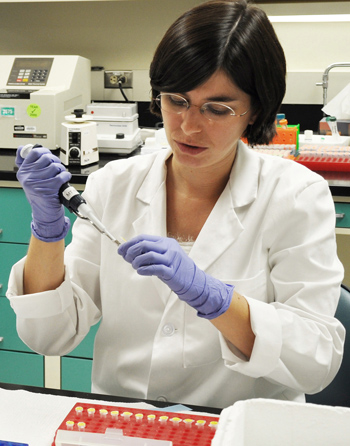For Consumers
Landmark Birthday for FDA Research Center
 Get Consumer Updates by E-mail |
Get Consumer Updates by E-mail |  Consumer Updates RSS Feed |
Consumer Updates RSS Feed |  Share copies of this article (737 KB)
Share copies of this article (737 KB)
 |
|
This campus in Jefferson, Arkansas, houses all National Center for Toxicological Research operations, as well as the Arkansas Regional Laboratories, another FDA facility. For more photos of NCTR, visit Flickr. |
 |
|
A biochemical toxicology scientist in the NCTR lab. For more photos of NCTR, visit Flickr. |
On This Page:
A federal research center born in the Cold War era is celebrating its 40th birthday and its reputation as one of the world’s premier science centers.
The National Center for Toxicological Research (NCTR) is marking its anniversary by formalizing a partnership with the state of Arkansas to create a virtual Center for Regulatory Science. The center’s goals will include modernizing this field of research to bring safer products to the market faster, and increasing the understanding of the potential toxicity of nanotechnology-based products.
But all of NCTR’s work, which spans many fields of science and includes a smorgasbord of new technologies, is really about regulatory science, explains Center Director William Slikker, Jr., Ph.D. The center’s focus is on both the development of new approaches to evaluating the safety of products regulated by the Food and Drug Administration (FDA) and the creation of data sets that substantiate and guide regulatory decisions, he says.
NCTR researchers often study a product before it’s even gone through clinical trials. At other times, they study products that have been around a long time but have unforeseen qualities. No matter what the product or health issue, Slikker says, “We develop data to fill the knowledge gap.”
Ordered Into Being by Nixon
In 1971, President Richard Nixon announced the establishment of the National Center for Toxicological Research on 500 acres in Jefferson, Arkansas. The site was once part of the U.S. Army’s Pine Bluff Arsenal but when President Nixon ordered the creation of this new center, it got a new home—the FDA.
NCTR’s initial mission was to study the effects of toxic chemicals on people and their environment. In the 40 years that have followed, NCTR has established itself as an internationally renowned research center, one that studies toxicity in chemicals, drugs and food, in addition to identifying the biomarkers for terrorism. The center studies human susceptibility to toxicants and the risk of disease. Toxicants are chemical, biological or physical agents that can be harmful to people, plants and animals.
The multidisciplinary teams of researchers—partnering with colleagues in other government agencies, industry and academia—also tackle a spectrum of personal and public health issues, including those affecting women and minorities in particular, as well as foodborne pathogens, and personalized nutrition and medicine.
The center has more than 500 scientists and other personnel in 30 buildings, in addition to the students, postdoctoral fellows, visiting scientists and FDA staff who come to NCTR to learn new technologies. “We’ve trained hundreds of individuals over the years,” says Slikker.
“An important part of modernizing the FDA ... to better protect and promote the public health.”
Making It Official With Arkansas
To celebrate its birthday, FDA and NCTR are taking that research another big step further with the signing of an agreement with the State of Arkansas to create the Center of Excellence for Regulatory Science.
Slikker explained that the agreement is, in a sense, a formalization of NCTR’s long association with researchers at the University of Arkansas for Medical Sciences and other state universities and institutions. There will be a particular focus on the study of the safety and efficacy of nanotechnology, he says.
The center is virtual in the sense that its work will be conducted in both state and federal facilities. There will be an expanded sharing of resources, facilities and education initiatives that target both students and members of the public.
FDA Commissioner Margaret A. Hamburg, M.D., calls the agreement with Arkansas “an important part of modernizing the FDA through the leveraging of intellectual, human and financial resources to better protect and promote the public health.”
Beyond this, NCTR has developed technologies that could one day transform healthcare. They include:
- RAPID-B, a portable system that can instantly detect live pathogens (infectious agents that can cause disease)—such as E. coli 0157, Salmonella and Listeria. This can be used for on-site surveillance of food-producing facilities and for the detection of potential contamination of biological cells and tissues.
- Bioinformatics, the use of computers and math to answer questions about biology. In general, an example of this technology would be software tools that search for certain properties within DNA sequences. At NCTR, teams of scientists from academia, industry and the government have been working together to create the standards, approaches and bioinformatic tools that will enable researchers to mine rich fields of biological data.
- Improvements in scanning devices—noninvasive magnetic resonance spectroscopy and MicroPET—to provide informative, translatable and much lower-risk diagnostics.
- Nanotechnology in cancer therapy that could make it possible to target difficult-to-treat or inoperable cancers.
And there’s promising research underway in the area of personalized medicine, says Slikker. “How do you deal with large data sets and try to develop safety information that’s important to the individual—that’s personalized? This is really exciting."
This article appears on FDA's Consumer Updates page, which features the latest on all FDA-regulated products.
August 12, 2011







